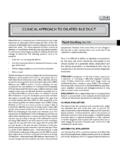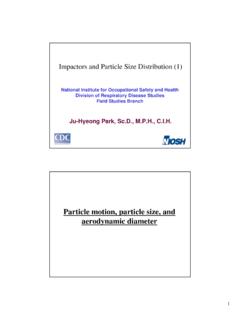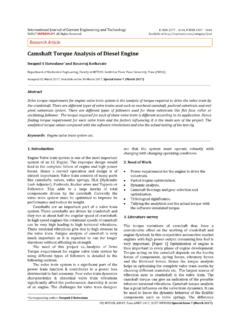Transcription of NOVEMBER 2010 Covering control, instrumentation, …
1 NOVEMBER 2010 Covering control, instrumentation, and automation systems worldwideVol. 57 No. 9tankers, railroad cars, or pipelines also get paid for the amount of materials they move. Companies that push gas through a pipeline, for example, operate on a slim margin of a few pennies per MCF (million cubic feet), so they want to know exactly how much is involved. Whether it is oil, gas, or chemicals, a tiny error of even in the flow measurement of materials being transferred can cost a company millions of dollars in one year. A very large custody transfer system can meter $6,000,000 worth of natural gas per day, or $ billion per year. If the measurement is off by , that s an error of $15,000 per day or $ million per year in some-body s favor. The terms custody transfer and fiscal metering are often inter-changed. Custody transfer takes place any time fluids are passed from the possession of one party to another.
2 It refers to metering that is a point of a commercial transac-Every process plant in the world takes in bulk raw materials and fuel from tanker ships, railroad cars, tanker trucks, or pipelines. Refineries, chemical plants, pharmaceutical companies, and a host of other industries have to measure raw materials and finished products accurately, because they pay for what comes in and get paid for what goes out. Transportation companies the ones who own the Emerie Dupuis and Gerard HwangDaniel Measurementand control, Emerson Process Management Custody Transfer: Flowmeter as Cash RegisterWhen bulk liquid or gas products change hands, everyone has to agree on the quantity and the product quality. This puts very special demands on 1: As this P&ID illus-trates, a custody transfer metering system has multiple flowmeters, valves, meter runs, flow provers, flow com-puters, thermowells, and analyzers.
3 Specially designed measurement and control systems such as Daniel s DanPac, provide the neces-sary records and auditable values for custody NOVEMBER 2010 CONTROL ENGINEERING such as when a change in ownership takes place. In general, custody transfer involves: Industry standards; National metrology standards; Contractual agreements between custody transfer parties; and Government regulation and transfer metering systems must meet requirements set by industry bodies such as AGA, API, or ISO, and national metrology standards such as OIML (International), NIST ( ), PTB (Germany), CMC (China), and GOST (Russia), among others. A number of flowmeter technologies are used for metering: orifice (differential pressure), turbine, posi-tive displacement, Coriolis, and ultrasonic. While the same basic technologies are used for normal process control, the very large volumes involved in most cus-tody transfer applications demand accuracy typically greater than for process metering, because it is the cash instance, liquid custody transfer meters used to measure refined hydrocarbons have accuracy of or better, and repeatability in the range of transfer requires an entire metering sys-tem that is designed and engineered for the applica-tion, not just flowmeters.
4 Components of a custody transfer system typically include: Multiple meters/meter runs; Flow computers; Quality systems (gas chromatographs for to mea-sure energy content of natural gas and sampling sys-tems for liquid); Calibration using in-place or mobile provers for liquid, or master-meter for liquid or gas; and Supporting 1 illustrates a typical liquid custody transfer skid, including multiple flowmeters and meter prover. Provers are used to calibrate meters in-situ. Proves are performed frequently, typically before, during, and after a batch transfer for metering and Coriolis flowmetersCustody transfer measurements have been around for a long time, and were often based on orifice flowme-ters, turbines, and positive displacement meters. These flowmeters induce pressure drop or have moving parts that wear out. Over the past ten years, Coriolis and ultrasonic meters have become the flowmeters of choice for cus-tody transfer in the oil and gas industry.
5 Ultrasonic meters provide volumetric flow rate. They typically use the transit-time method, where sounds waves transmitted in the direction of fluid flow travel faster than those traveling upstream. The transit time difference is proportional to fluid velocity. The aver-age axial velocity multiplied by the area of the pipe then gives the uncorrected volumetric flow rate through the ultrasonic flow meter transmitter. Mass flow rates can be determined in conjunction with flow meters have negligible pressure drop, have high turndown capability, and can handle a wide range of applications. Crude oil production, transportation, and processing are typical applications for this technology. Their full-bore configuration can match the pipe diameter to minimize compression or pumping energy required to move oil or gas over thousands of pipeline miles across continents.
6 Newer meters extend the temperature and viscosity range to address applications like the heavy crudes found in oil sands and oil shale. Advanced models have extensive diagnostics which help reduce measurement uncer-tainty and simplify operations. Spool-piece ultrason-ic meters are commonly available in 2 to 24 in. pipe flowmeters provide direct mass flow mea-surement, with high accuracy and repeatability over wide turndown ratios. They maintain those quali-ties even when fluid conditions such as density, vis-cosity, and composition change frequently. Micro Motion first introduced Coriolis meters to the mar-ket in the 1970s. In 2002, after decades of successful measurement, the American Petroleum Institute (API) approved their use for custody transfer applications (API Chapter ). Coriolis meters are used on lines from less than 1 to 12 in.
7 In search of accuracyAccuracy refers to the closeness of the measurement to the true or accepted value. Each device (flowmeter, pressure transmitter, temperature sensor, BTU analyz-er, etc.) has its manufacturer-stated accuracy specifi-cation and its tested accuracy. Uncertainty takes all the metering system factors that impact measurement accuracy into account. So, two accuracy flowmeters could be used in two different metering systems that ultimately have different calculated uncertainties due to other things in the system that Figure 2: Typical instal-lation of an ultrasonic meter has a five diam-eter (5D) settling zone approach section ahead of the conditioner plate and a ten diam-eter approach section between the plate and meter. The 5D discharge section allows suffi-cient space to locate a thermowell 2-5D down-stream (typically 3D). process CONTROL ENGINEERING NOVEMBER 2010 3 affect flow calculations.
8 Uncertainty even includes such factors as the flow computer s A/D converter using an ultrasonic flowmeter (USM) for custody transfer of natural gas, here are some of the items that must be considered:Meter tube alignment: The piping leading up to and away from the ultrasonic sensor must be aligned perfectly. AGA 9 allows the tube-to-meter match to be within , so for a tube with a bore of inches, AGA allows a misalignment of up to about in. This is a huge gap, and a USM can normal-ly deal with the mismatch if the registration is con-centric. Recent tests show that eccentric connections that leave edges can cause errors of up to Most good tube manufacturers will align to within a few thousandths of an inch. Distance from control valve: Noise from control valves can interfere with an ultrasonic sensor s mea-surement, so a good practice is to place valves down-stream of meters (if possible), put as much distance as possible between valves and meters, and put some bends in the piping to reduce noise.
9 Noise trap tees are very effective in reducing valve noise. In a simi-lar fashion, Coriolis meters can be affected by vibra-tion, so they need their own form of protection. Headers: A typical custody transfer system has multiple flowmeters installed across a single head-er. This arrangement can allow for one flowmeter to occasionally be used as a master meter or refer-ence meter, while the other flowmeters are routinely used to measure fluid flow. It also allows an individ-ual meter run to be isolated so that it can be serviced, removed, cleaned, or calibrated without shutting down the line. Sizing headers: Cost increases as the header size increases, but performance suffers if headers are undersized. Header sizing sounds like a very basic concept that every engineer should know, but we have seen a large number of incorrectly sized head-ers on legacy systems.
10 Temperature sensors: The location of temperature sensors is critical for maximum accuracy. (See figure 2.) For gas, AGA 9 recommends the thermowell be installed between two and five diameters downstream of the flowmeter in a uni-directional system, and three diameters from the meter in a bidirectional installation. Flow provers: One flowmeter is designated as the flow prover. (See figure 3.) This is a flowmeter of exceptional accuracy, and one that has been calibrated and tested recently. In some cases, for large pipe sizes (30 in. and larger), the flowmeter has to be shipped to a calibration facility capable of handling something of that size. For smaller units, portable flow provers can be brought to the plant site to serve as a calibrator. During operations, a meter to be tested is aligned in series with the master meter prover by way of valving. The flow computer compares the output of the two flowmeters to calculate the error between them.















